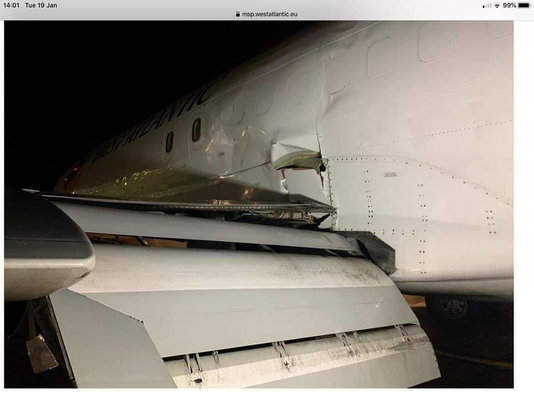734 hard landing @ Exeter
A photo of the airframe post the accident here shows that the structure is no longer equally supported by the undercarriage. The cargo is still aboard as it is currently too dangerous to remove it.
https://samchui.com/2021/01/19/west-...a#.YAdUty3fWfB
https://samchui.com/2021/01/19/west-...a#.YAdUty3fWfB
At first glance, the photos appear to show that the LH inboard flap has dropped.
But look closer and it can be seen that it's not the flap that has moved, but the upper surface of the wing root that has been pushed up by the MLG trunnion trying to break through.
But look closer and it can be seen that it's not the flap that has moved, but the upper surface of the wing root that has been pushed up by the MLG trunnion trying to break through.
Join Date: May 2007
Location: Up there
Posts: 77
Likes: 0
Received 0 Likes
on
0 Posts
Would be interesting...Hard landing checks are carried out for any landing above (I think) 2,1 Gs, but a technician once mentioned to me that even a 3-4G landing (!) probably wouldn't cause major damage on the 737, longer versions being more critical than shorter ones. Would also be interesting as to what happened - weather doesn't look to bad / gusty... [EGTE 190220Z 23010KT 9000 -RA SCT012 BKN040 12/10 Q1009=] - source avherald.
Join Date: Apr 2016
Location: Devon, UK
Posts: 6
Likes: 0
Received 0 Likes
on
0 Posts
We're a few miles south-west of Exeter and I can remember hearing the wind hitting the house during Monday night/Tuesday morning so 10 knots seems like a surprisingly low forecast. Looking at FR24 the ground speed on approach was varying fairly rapidly between 111 and 133 knots, so I'm guessing they were dealing with some reasonable gusts. Data also shows a VS of -1,024 FPM over the threshold, but the aircraft was apparently still airborne as it reached the intersection with the old RWY13/31.
That's a nasty thing to happen to anybody. Hope the crew are OK.
TGZ let us assume that the FR24 data does not give an accurate touch down point. I do not know if it does or not. But if it was accurate and they were still airborne at the intersection of the old RW31 then that was not the place to be in a 737. Let us see what more data provides...
Join Date: Apr 2016
Location: Devon, UK
Posts: 6
Likes: 0
Received 0 Likes
on
0 Posts
Good point. I'm not familiar enough with either the inner workings of ADS-B or what internal processing FR24 do to their data to speculate on how accurate it might be. Thankfully whatever happened there was a safe outcome for the crew, if not the airframe.
Had to take the car to the garage this morning and could see CY on the apron as we drove past the airport - I swear the aircraft is actually tilting several degrees to the left.
Had to take the car to the garage this morning and could see CY on the apron as we drove past the airport - I swear the aircraft is actually tilting several degrees to the left.
But if it was accurate and they were still airborne at the intersection of the old RW31 then that was not the place to be in a 737.
It wouldn't be altogether surprising if hitting the runway with enough force to drive the gear up through the wing had also done strange things to the Mode S air/ground logic.
Human factors, rather than bad weather, is my theory as to the main cause of this accident. The Circadian Rhythm at 02:00 in most humans demands deepest sleep, with lowest body temperature occurring at 04:30. This accident occurred close to the lowest point in the average person’s alertness cycle.
Last edited by Nightstop; 20th Jan 2021 at 19:11. Reason: Comma added for clarity
Pistonprop:
This safety issue has been highlighted ad infinitum. Here is a FSF article on the subject. I’ve no connection with this Company or anyone involved whatsoever.
https://flightsafety.org/hf/hf_mar_apr99.pdf
This safety issue has been highlighted ad infinitum. Here is a FSF article on the subject. I’ve no connection with this Company or anyone involved whatsoever.
https://flightsafety.org/hf/hf_mar_apr99.pdf
Join Date: Jan 2018
Location: Chicken Town
Posts: 20
Likes: 0
Received 0 Likes
on
0 Posts
This happened on the first night of what would be 5 nights of duty.
First night into the WOCL is the toughest. Incredibly difficult to rest for, weekend off with all the normal home triggers to get you up and going. And if you’ve got kids they’re not even at school at the moment if you’re trying to rest on a Monday. So I’d say human factors would be a very relevant area of mitigation.
First night into the WOCL is the toughest. Incredibly difficult to rest for, weekend off with all the normal home triggers to get you up and going. And if you’ve got kids they’re not even at school at the moment if you’re trying to rest on a Monday. So I’d say human factors would be a very relevant area of mitigation.
Join Date: Mar 2000
Location: UK
Posts: 173
Likes: 0
Received 0 Likes
on
0 Posts
I think it very much depends on the individual. To me, if properly rested previously (i.e. having had enough sleep during normal patterns), the first night is alright. But the second and third nights for me hurt more until the body clock at least adapts slightly.
I swear the aircraft is actually tilting several degrees to the left
Local reports that the airframe is bent to the point that the ULD's could not be pushed off.




